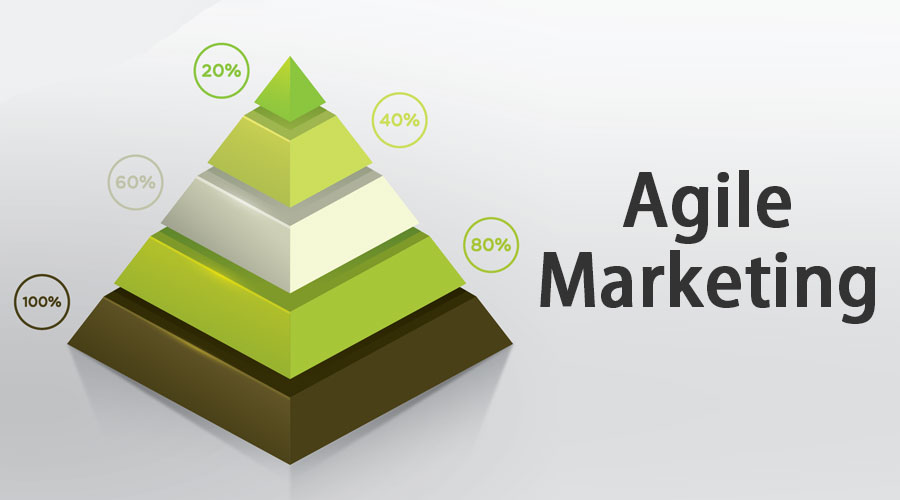Updated May 25, 2023
Introduction to Agile Marketing
Agile marketing is a methodology invented by software developers, enabling you to become more effective by putting in the same amount of work. Agile marketing is a strategic marketing approach where the marketing team communally identifies essential projects of high value to focus on. The entire team then completes these projects, and their impact measurement continuously improves over time. Agile marketing makes the marketing department more efficient. It enables the team to work unitedly with the sales department, customer service, and the other departments in the company to get fast feedback and better results.
Need
- Agile marketing keeps the company ahead by disintegrating the project into smaller portions known as “sprints.” They are then rapidly addressed according to the changing market conditions and data collected from customers’ other prospects. These sprints can cover two to four weeks.
- It enables the marketing department to adapt to the ever-changing environment rapidly, new strategies are integrated, better-suited technologies are adopted, and focus is kept on the most effective ones.
- The company can take advantage of the upcoming new trends, products can be brought to the market faster, and thus competition can be handled.
- Agile marketing brings value to the business in the form of profitable revenue growth and is also beneficial to the customer.
Developing an Agile Marketing Team
- For agile marketing to develop, it needs to have specific prerequisites. The organization must have a clear vision of what it wants to accomplish with the agile initiative. Sufficient data, analytics, and proper infrastructure should be present. The senior leaders must also shift to agile so that there is support whenever this new working method encounters resistance.
- Another essential feature is to bring together a small but talented team of people who can work with speed and possess the required skill, which can be released from the day-to-day business to work together full-time. The team needs to be small enough to be accountable to each other, 8 to 12 being the maximum size.
How Does an Agile Marketing Team Work?
Below is a list of work/processes for a successful agile marketing team.
1. Aligning with the Leadership and Setting Goals
Firstly, the team meets with the leaders of the marketing department to identify the goal. The former rules and norms do not apply, regular collaboration, speed, putting aside the regular business, discussing opinions, and keeping the customer at the center of all decisions.
2. Analyzing Data and Identifying Opportunities
Now the real work of putting in insights begins. Identifying irregularities and issues is on the agenda. A standup meeting is held each morning for a quick report on what has been accomplished the previous day and the plan for that day. This is a potent practice as everyday accountability makes all strive harder to achieve.
3. Designing Tests
For every irregularity or issue that has been identified, the team develops ideas and a method to test those ideas. The testing methods have key performance indicators (KPI). The tests generally have two criteria: the impact on business and easy implementation.
4. Running Tests
Tests are run to check whether the implemented ideas have worked. The team must demonstrate efficiency by keeping meetings short and to the point and assembling a streamlined production and approval process.
5. Agile Organization
As the team works its way through tests, the results of these tests will start showing across the marketing organization. As the tests generate promising results, more agile teams can be added, paralleling a company. Each team should focus on a specific goal, product, or service based on the company’s requirements. We should only add new agile teams when the existing one is operating effectively.
As the agile teams grow and their capabilities increase, they can also take responsibility for establishing and executing business rules.
Agile marketing allows an organization to:
- Response fast to the changes in the market.
- We should produce campaigns to test, enhance, and upgrade over time.
- Try various processes and repeat the ones that succeed.
- Improve marketing efforts by using inputs from other departments.
- Choose the best campaigns and projects based on actual data.
- Work together with team members for the best approach.
Implementation of Agile Marketing
Every department will have a different agile format that will work best for them, but its implementation will have these four features in some form.
1. Sprints
We give the team this time to finish its current work. It can range from 2 to 6 weeks. Some projects may be large enough to need more than one sprint to manage the work better in parts.
2. Stand up Meetings
Every morning, we should conduct a fifteen-minute standup meeting to discuss the work completed the previous day and plan for the day’s work. We should discuss and sort out any obstacles or issues right away.
3. Tracking Project Progress
Everyone should have an easily accessible way to track the sprint, whether a whiteboard or software so that the related points can be noted down then and there.
4. Teamwork
One person might own a project, but the success or failure of the project lies in all the team members. It is the cooperation and collaboration of all.
“Going Agile” “is not something we can cross off our list once we adopt the procedure. It generally takes two to four months to start seeing the benefits. Even after these few months, the organization will keep finding new ways of improvement. To avoid stagnation, someone on the team must be dedicated enough to continually perfect changes because we all agree there is always room for improvement. All we need to do is to keep identifying those opportunities which need to be improved.
Recommended Articles
This has been a guide to Agile Marketing. Here we discussed the basic concept, working, need, and implementation of agile marketing. You can also go through our other suggested articles to learn more –




